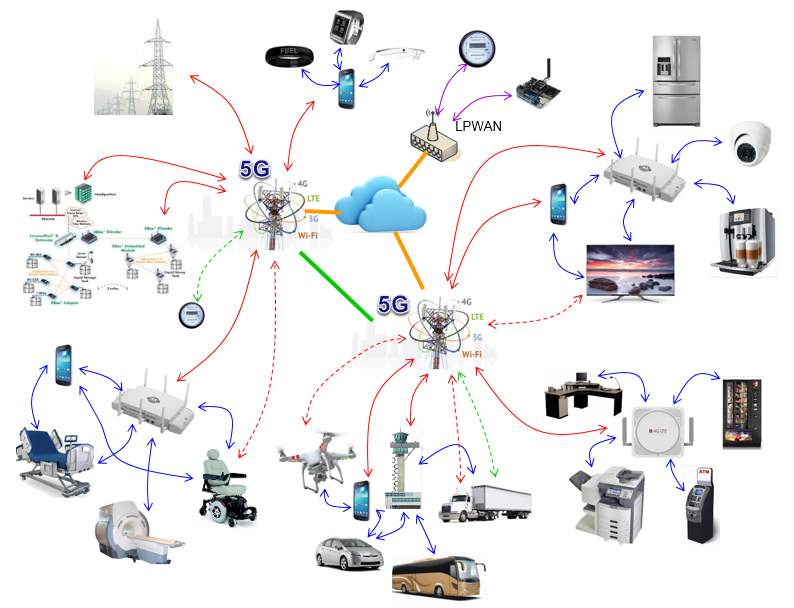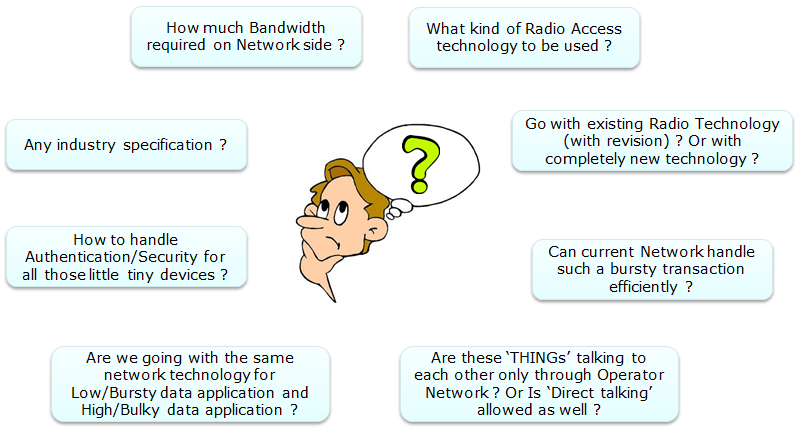|
IoT (Internet Of Things) |
||
|
What is IoT ?
For the past several month (as of Jan 2015), I have been hearing two words that everybody was talking about but nothing is clear about it in terms of technical details. One of them are 5G and the other is IoT (Internet of Things). I have been following up various news about 5G and had a dedicated section for 5G and now I am about to talk about IoT.
What is IoT ? It stands for Internet of Things. Basic idea is to connect EVERYTHING that you can think of by Internet. One small snapshot of connection would be as shown below.
I am using my own color coding to explain the situation in more detail.
You might have different interests in type of links depending on which industry you are working in. Personally I am more interested in solid red and dotted red line since I am in this area. It would be interesting to see which line gets thicker and which line gets thiner as time goes on.
Are We Ready ?
Goal for IoT is clear. That's is.. 'Connect Everything by Internet'. The question is "Are we ready for this technicaly ?",
"Do we have all the technical compoents to achive the goal ?".
The answer is "NOT YET !" (But I will put down some of the recents observation below the following illustration)
Followings are some of the questions that pops up in my mind and I think we need to have clear answers at least to these questions before we start tyring to make any specific things.
But don't be disappointed too much. I think IoT is at least a little bit better than 5G in terms of technical details :). We start having some industry standards for this and I think I can find some answers (partial answers) to thease questions. I will keep posting pages that would provide answers to these questions. Even though there is no perfect answers, it is always good practice for you to have your own questions before you study/develope anything in engineering.
Are you confused ?
Yes, I am confused. For a while, I have been searching/watching/reading/devouring YouTube, web pages, WhitePapers and Specification documents about IoT. When you start reading about IoT, I am pretty sure that you will see some words about M2M and now start searching about M2M. And when you searching M2M and reading them, I am pretty sure that you will hear something about MTC, D2D. Then while I was googling about MTC, D2D and I started hearing about LTN and realized that even ETSI specification are released about LTN. In addition to Cellular based IoT/M2M, many kinds of other network and short range wireless protocols that are designed for IoT/M2M or revised from existing application for IoT/M2M application, now we have even more confusing bubbles as illustrated below. If you are confused with this diagram, I would say my mission accomplished. This specific section is to confuse you :). Read through other sections and pages and get back to this sometimes. If this does not confuse you any further, your study on IoT is done :)
I think I start understanding what each of these are talking about on its own, but I am still confused about how all of these interplay each other. For now, in stead of trying too hard to get out of the unclear status I just decided to keep accumulating whatever I find. I am pretty sure that things would be clear by itself when I just have enough information/data compiled. This is how human brain works.
Reference (documents/video)
[1] M2M Summit 2014 | Joachim Dressler: Is LTE changing the M2M world? [2] Machine-to-Machine (M2M) Tutorial Trailer for IEEE ComSoc Tutorial Now [4] NB-IOT - Enabling New Business Opportunities (HUAWEI)
YouTube
|
||


